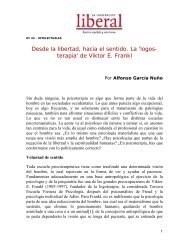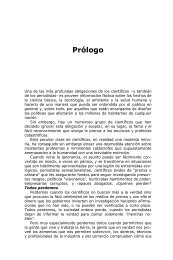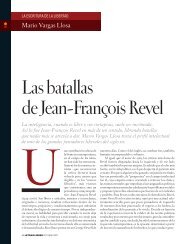Darfur: Blueprint for Genocide - Archipielago Libertad
Darfur: Blueprint for Genocide - Archipielago Libertad
Darfur: Blueprint for Genocide - Archipielago Libertad
You also want an ePaper? Increase the reach of your titles
YUMPU automatically turns print PDFs into web optimized ePapers that Google loves.
Humanitarian aid was denied. Government reactions to<br />
outbreaks of disease were to herd the displaced Dinka<br />
closer together, and medical attention was denied.<br />
Children were kidnapped and herded into camps where<br />
they were <strong>for</strong>cibly Islamized. This a clear example of the<br />
<strong>for</strong>cible transfer of children from one group to another – an<br />
action prohibited in Article 2e of the <strong>Genocide</strong><br />
Convention. 11<br />
Jihad was also declared specifically against the Nuba in<br />
Kordofan in 1992, three months after the jihad on the<br />
South. Approx imately 50% of Nuba w ere Muslim, a large<br />
proportion of the population relative to other populations in<br />
the South. The jihad was aimed as much against the<br />
Muslim population as it w as against the Christian and<br />
animist Nuba. It is evident that racism motivates these<br />
atrocities as much, if not more, than religion even though<br />
religious language was used to ‘justify ’ these atrocities.<br />
Nuba villages were terrorised and destroyed by the PDF<br />
and Arab militias leading to resettlement of 170,000 and<br />
the deaths of an estimated 100,000. 12 Like the Dinka, the<br />
Nuba were rounded up into ‘Peace Camps’ where they<br />
were confined <strong>for</strong> Islamization. The ‘Peace Camps’ were<br />
set up in hostile environments where the means <strong>for</strong><br />
survival were minimal. The land from which the Nuba were<br />
removed was sold to supporters of the regime. 13<br />
There are many similarities between the methods used<br />
against the Nuba in 1992 and the methods being used in<br />
<strong>Darfur</strong> now. The specific targeting of the male population,<br />
the raping of women and the stated intention of the<br />
Sudanese Government to create safe areas into w hich to<br />
put the internally displaced are all taking place in <strong>Darfur</strong><br />
and reflect thecrimes towhich theNubaweresubjected.<br />
2.3 A comment on ethnicity: Arabs<br />
and Africans?<br />
Some scholars understandably object to simple<br />
descriptions of ethnic relationships in Western Sudan<br />
being portray ed as Arabs against African Sudanese or<br />
non-Arabs. The authors are aware that ethnic history and<br />
relationships are often more complex. In times of peace,<br />
in particular, there is fluidity of ethnic identity including<br />
intermarriage between groups and tribes.<br />
11 Fein, H (2002). <strong>Genocide</strong> by Attrition in Sudan, Crimes of War<br />
Project, http://www.crimesofwar.org/sudan-mag/sudan-fein.html,<br />
[Accessed 12 November 2004].<br />
12 Collins, R.(2004) The Sudan<br />
http://www.gale.com/enewsletters/history/2004_08/sudan.htm<br />
[Accessed 12 November 2004].<br />
13 Johnson, D. (2003). The Root Causes of Sudan’s Civil Wars,<br />
International African Institute, London, p. 133.<br />
Section 2: <strong>Darfur</strong> and the Ideology of Sudan<br />
Many Sudanese argue that most ‘Arab’ Sudanese are<br />
black and African in origin anyway. Over the centuries<br />
tribes assumed an Arab identity – the w hole family<br />
speaking Arabic as a first language, not just the educated<br />
men. Being ‘Arab’ differentiated them from people<br />
regarded as slaves. While it may not always have been<br />
the prime reason <strong>for</strong> assuming an Arab identity, it would<br />
hav e af<strong>for</strong>ded protection from being taken into slavery<br />
themselves or from being massacred. Today hav ing an<br />
Arab identity disassociates a family from the stigma of<br />
being descended from slaves. This is ex emplified in parts<br />
of Old Khartoum where it is currently unacceptable <strong>for</strong><br />
intermarriage betw een so-called Arabs and so-called<br />
Africans. This is much more to do w ith culture and<br />
language thanskin colour.<br />
When a group is threatened, how they perceive their<br />
identity , or indeed how sociologists or anthropologists view<br />
it, becomes immaterial. What matters is how a dominant<br />
or threatening group perceives them.<br />
‘Arab’ or ‘Black African’? As a new arrival at Breidjing<br />
refugee camp, eastern Chad, this man’s identity has already<br />
been determined <strong>for</strong> him by the Janjaweed and Sudanese<br />
security <strong>for</strong>ces.<br />
An ex ample from the past: German Jews had assimilated<br />
and intermarried <strong>for</strong> several generations by the 1930s.<br />
Many perceived themselves as ‘more German than the<br />
Germans’. The Nazis did not describe them that way. It<br />
was the perpetrators’ definition that became significant.<br />
So it was <strong>for</strong> millions of others in Europe. They defined<br />
themselves in one way, possibly in a complex way, or in<br />
no w ay at all because it just w as not v ery important to<br />
them. But w hen the chips w ere down, it w as the<br />
perpetrators’ perspective that counted. Even Catholic<br />
nuns were deported to Auschw itz and gassed when they<br />
were found to have a Jewish parent or grandparent.<br />
To the perpetrators of genocide, identity is very important.<br />
They simplify it, augment it and create an ‘enemy ’. The<br />
8



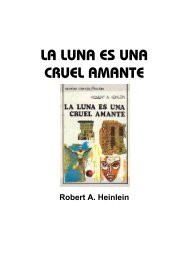
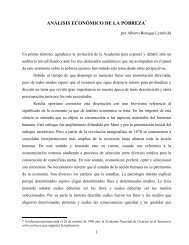
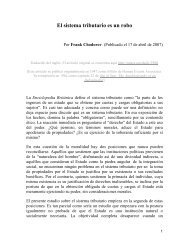
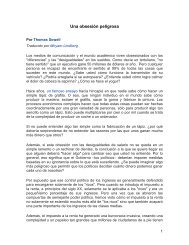
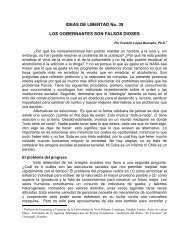
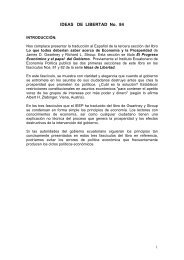


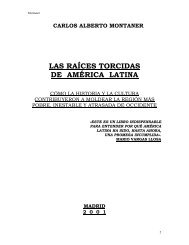
![0091 Stewart - La magia y el misterio del comercio [parte I].pdf](https://img.yumpu.com/16943279/1/169x260/0091-stewart-la-magia-y-el-misterio-del-comercio-parte-ipdf.jpg?quality=85)
